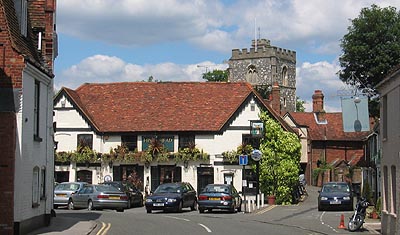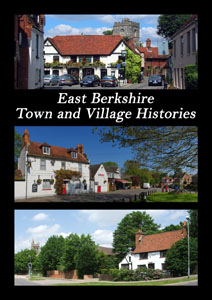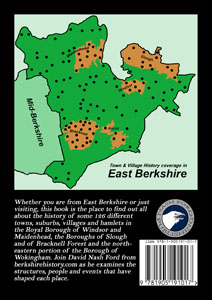 |
 |
||||||||
|
|
Bray was once thought to have been Bibrax (or Bibracte) to the Romans, but this place never existed and was made up by the medieval cartographic forger, Richard of Cirencester. There does appear to have been Roman activity in the parish, however, especially in the Water
Oakley area. A supposed broken ‘Sheela-Na-Gig,’ up in the rafters of the present church, may have come from the old building. This Irish name refers to a small stone female figure with large breasts and legs spread wide representing the Celtic mother goddess and incorporated into churches to remind the faithful of the temptations of the old religion. A less controversial relic of the old Anglo-Saxon church is the carving of a horse or a dog encased in the walls of the Chantry Chapel of Our Lady that stands in the churchyard. It had its own chantry priest who lived in the cottage built over the lychgate in 1448. This later became the Six Bells Inn, named after the instruments hanging in the church. The parish church has two further chantry chapels within its walls, built to pray for the souls of the founders: the Foxley Chapel of All Saints at the end of the south aisle and the Norreys Chapel of St Nicholas in the north aisle. The building has some fine monuments, some moved from these chapels and others long lost. The superb brass to the armoured Sir John Foxley (died 1378), from Foxley Manor at Touchen End, and his two wives in their heraldic dresses commemorates a soldier of the Hundred Years’ War. He and his first wife eloped together at the age of only fourteen. The monuments to two branches of the Norreys family from Fifield and Ockwells at Cox Green have largely disappeared. Sir John, the builder of Ockwells House and the Lancastrian Master of the Royal Wardrobe during the Wars of the Roses, left instructions for his burial at Bray in an impressive marble tomb in 1467. Only his beaver-supported coat-of-arms survives on the wall, but there is also a 1591 incised mural slab to William Norreys of Fifield, the ‘Black Rod’ to Queen Elizabeth I. Perhaps the finest monument features the striking demi-figure sculptures of William Goddard and his wife, who founded the Jesus Hospital in 1609. This beautiful almshouse, with his full-height statue over the entrance, was built to house thirty-four of the parish’s aged poor, as well as six from the Fishmongers’ Company to which Goddard belonged and is still in use on the road to Holyport. The Hind’s Head in the village is a 15th century hall-house. Its origins are obscure, but it may have been a royal hunting lodge or cottages for the church builders. It was certainly a guesthouse of the Abbot of Cirencester who owned Bray Church from 1133. The Duke of Edinburgh held his stag party there in 1947. It is now a single Michelin starred gastro pub owned by Heston Blumenthal, who also owns the Crown. Bray is most famous as the location of the only restaurants outside London with 3-Michelin stars, both Alain Roux’s Waterside Inn and Blumenthal’s Fat Duck. In centuries past, however, it was best known as the home of the ‘Singing Vicar of Bray,’ the star of a well-known ballad. He supposedly promised to remain “the Vicar of Bray, Sir” no matter what religious denomination he had to adopt. The ballad indicates he was Francis Carswell (Vicar 1650-1709), but the story was recorded of the rector, as early as 1662, through the turbulent Tudor years. This period has two possible candidates: Simon Simonds (1523-47), an ancestral cousin of the Reading brewers and brother of one of the Windsor Martyrs, whose death could have inspired his maxim; or Simon Alleyn (Vicar 1523-65) who was buried in the middle of the nave after a very long service as vicar. A famous hotel not far east of the village is the Monkey Island Hotel, named after the islet in the Thames on which it stands. The name is popularly supposed to recall the painted monkeys fishing and shooting on the hotel ceiling. However, it was originally Monk’s Eyot and was used by the brethren from Merton Priory’s grange at Taplow. For centuries the island was part of the Whiteknights Estate in Earley and, in 1744, the 3rd Duke of Marlborough had a fishing lodge and banqueting temple built there for use when attending the Kit-Kat Gentlemen’s Club at Down Place in Water Oakley: hence the fishing monkeys painted by Andrieu de Clermont. However, a romantic old story, with no evidence, suggests they actually represent the pet monkey of King George III who was allowed to stay there during his fits of madness. In 1840, the two buildings were expanded and converted into a hotel which has always been popular with high society. HG Wells and his lover, Rebecca West, were frequent visitors and the latter set her first book, ‘Return of the Soldier,’ there. King Edward VII and Queen Alexandra were also particularly fond of the place. Read more history of
Bray and other settlements in the parish in David Nash Ford's book, 'East Berkshire Town and Village
Histories'.
|
||||||||
| © Nash Ford Publishing 2001; Revised 2020. All Rights Reserved. | |||||||||



 Bray
Bray
